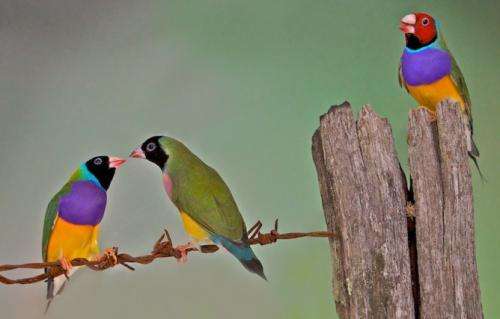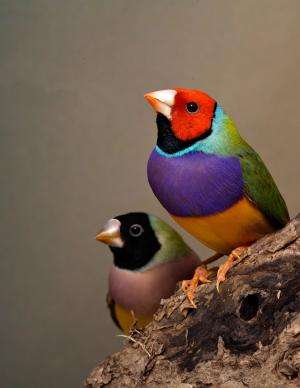Male Gouldian finches select mates using only left side of brain, study finds

Choosing a mate is one of the most important decisions an individual of any species will make in its life. It is therefore perhaps a surprise that a new study, of which I'm a co-author, has revealed a bird puts only half its mind into the mate-selection process.
Our study – led by Jennifer Templeton of Knox College, USA – is published today in Biology Letters and reveals the preference for attractive or unattractive mates is made in just the left side of the brain.
We were able to demonstrate this using a simple experiment that works because, in birds, visual information to the left-hand side of the brain comes from the right eye.
The Gouldian finch (Erythrura gouldiae) comes in two forms, with both males and females having either red or black heads. Typically, males prefer to associate with and partner females that have the same head colour as themselves.
In our study, males were allowed to choose between associating with differently coloured females and also whether they preferred to associate with a female over a male.

The catch was that in experimental trials the males had a temporary eye patch (which you can see here modelled by a zebra finch) placed over the left eye, the right eye, or neither eye. When males were able to use both eyes, or the right eye alone, they consistently choose to hang out with the female of the same head colour as themselves and also spent more time courting these females by singing to them.
But when males had the eye patch placed over their right eye, and could only use their left eye for viewing potential partners, they were unable to discriminate between the different females, and did not spend as much time courting them with song.
Perhaps even more surprisingly, males that were not able to view subjects with their right eye did not even allocate more time to females than males.
This study will help us uncover the mechanical process underlying what is actually a very complex decision – deciding who will make an attractive partner. The findings demonstrate mate choice is lateralised in the brain – occurring predominantly in one specialised region, in one half of the brain.
An interesting consequence of this finding is that, because the important left side of the brain receives input on potential mates from just the right eye, it would pay individuals to approach and court individuals predominantly from the right-hand side.
The idea of picking apart the mechanisms at the heart of attractiveness and mate choice in these finches might seem very far removed from our own emotional experience of mate choice and love.
But the findings of brain lateralisation with respect to mate choice in these finches actually tie in very nicely with a 2005 study of humans.
That particular study used functional magnetic resonance imaging (fMRI) on 17 people who were intensely "in love", and found when the individuals thought about their partner, they activated a few key areas in just the right side of their brains.
There is still much research to be done on the mechanisms that govern mate selection – in finches and in other species – but our study gives valuable insight into where, in the brain, this process occurs.
More information: rsbl.royalsocietypublishing.or … 09/26/rsbl.2012.0830
Journal information: Biology Letters
Source: The Conversation
This story is published courtesy of the The Conversation (under Creative Commons-Attribution/No derivatives).















